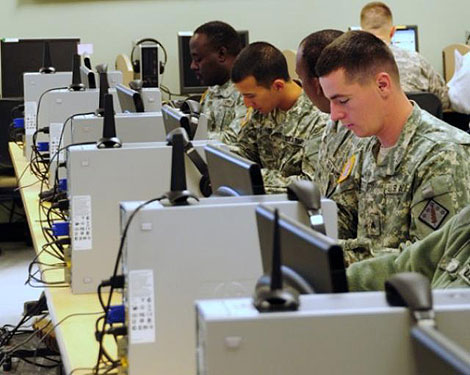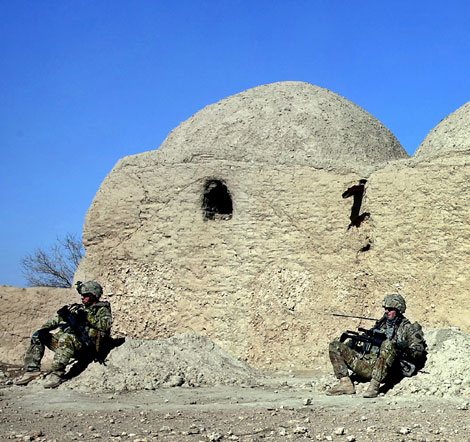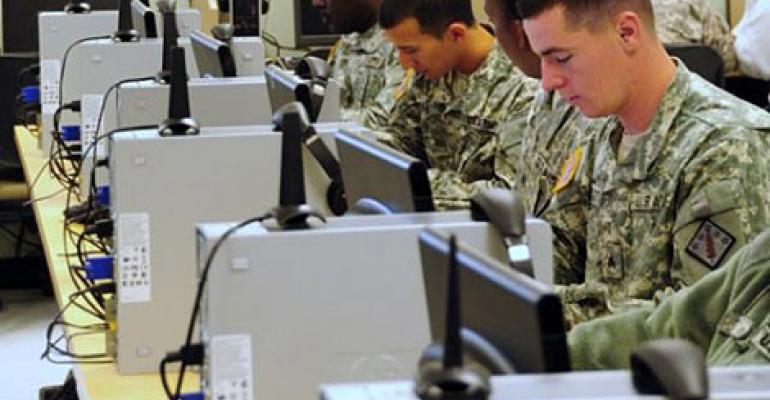
Soldiers at the Fort Stewart, Ga. Education Center work on class material and catch up on their e-mail. The adoption of the cloud by U.S. Department of Defense has helped soliders in the United States and deployed abroad to stay connected with their families. (Photo: U.S. Army)
As the U.S. Department of Defense (DOD) adopts new types of globally distributed technologies, it is working to improve communications for servicemembers, both on the battlefield and with family at home.
While those of us in the corporate world may take for granted the ability to clearly relay a message between multiple parties, communications in the military's IT world can be critically important.
The military's shift in technology is happening at all levels and the DOD is fully embracing the new infrastructure push. Just two years after its inception, the Department of Defense Enterprise Email system has reached its one millionth user. This milestone means that the DOD Enterprise Email (DEE) is now one of the largest independent email systems in the world.
"For the war fighters, using DEE means wherever they are, they can use their email, whenever they need it. It is not necessary to start a new email account when you move or deploy. It is as mobile as the servicemember," said Air Force Lt. Gen. Ronnie Hawkins, Director of the Defense Information Systems Agency (DISA).
With so many important users at any given time, the DOD and DISA are working to ensure optimal performance and maximum communication capabilities for U.S. troops. The landscape for the typical soldier or sailor has changed quite a bit. Just a few years ago, communicating with home meant a long wait and a short chat. Now, with better WAN connectivity and solid infrastructure, U.S. soldiers based all over the world can connect with friends and family via everyday connection means. This could mean that a soldier at Bagram Airbase can communicate with his or her loved ones via Skype, Facebook and even Gmail.
These are truly common tools that civilians use every day. Now, because of the advancement in global distributed infrastructure designs, these same platforms can be used to bring home a little closer to the people defending the national interests abroad.
Here's a look at some of the behind the scenes infrastructure projects which are helping to bolster all cloud, Internet and WAN-based communications for the military.
Data Center Consolidation
The data center is changing to support more cloud, more data and a lot more users. The DOD quickly realized that it needed need to jump on this evolution bandwagon and update its data center infrastructure. With almost 1,200 data centers, there was a direct need to consolidate and deploy better, more efficient technologies. In fact, the same press release indicates that in using DEE, the DOD is doing just that.
DEE saves millions of dollars for the department by leveraging the buying power of the entire department. Enterprise services reduce costs by consolidating system hardware requirements and maintenance, eliminating unnecessary and inefficient administration and resource allocation. That means the military services and defense organizations using enterprise services can save money in IT services to preserve more resources for their primary mission.
Unified computing systems, converged infrastructures and intelligent hardware components are finding their way into the DOD’s data center environment. These high-density environments are capable of being locked down, diversified and given the opportunity to support numerous different services. These technologies are capable of virtualization and even logical segmentation of workloads. This means that administrators are able to granularly control how communications and data enter and leave their data centers.
Improved Global Infrastructure
Directly related to these consolidation and efficiency efforts has been the direct improvement within the global data center and communications infrastructure. What can be achieved now with intelligent switching technologies is truly amazing. One logical switch controller is able to deliver hundreds - even thousands - of virtual connections. These connections are able to be controlled and can cross-communicate when necessary. Virtual appliances can be deployed within various points in an environment creating a highly agile system. Software-defined networking has helped the DOD create more redundancy on a global scale. Furthermore, the increase in bandwidth and direct communication links has improved the type of information that can be passed point-to-point. Plus, the speed at which such data travels has greatly increased as well.

U.S. Army soldiers lean against a mud wall during a break from combat operations in Kandahar province in Afghanistan. The soldiers, who are deployed far from home, such as these from 504th Battlefield Brigade's 38th Cavalry Regiment, are supported by a global IT infrastructure. (DoD photo by Spc. Crystal Davis, U.S. Army.)
Furthermore, DOD and DEE architects fully leveraged this new type of design for its reliability and redundancy. In utilizing better technologies - which are capable of better consolidation and efficiency - administrators created a truly robust system which delivers true data continuity confidence. So, when the question around system redundancy and availability arise – DISA is ready for what may come its way.
“DEE incorporates built-in redundancies and support to prevent system-wide outages,” said Alfred Rivera, Principal Director, Enterprise Services for DISA. “DISA maintains absolute command and control of all enterprise email infrastructure assets.”
“We want our warfighters to know that they have the most reliable email system available,” said Rivera. “We’ve got their back. We are providing them with the key IT and communication tools they need to conduct their day-to-day mission."
In designing a truly redundant environment – just like with data center consolidation – there are various technologies working hard in the background. Aside from the fact that there are better switching designs and improved WAN-based connectivity - the used of global server load balancing (GSLB) and global traffic management (GTM) technologies further help direct data an information. There is the direct ability to send users to a data center based on location, the device being used, and or the workload that’s being accessed. Furthermore, if there is an outage, the user would never know. In using advanced global traffic management solutions, the user would be transparently forwarded to the next closest data center based on a set of predefined continuity or disaster recovery policies.
More Mobility and Security
In creating a more robust and efficient infrastructure, the DOD took careful notice of security and mobility. Even in the military, Bring Your Own Device (BYOD) and IT consumerization are important topics and technological considerations. DISA is working towards the delivery of information and content to end-points outside of the regular desktop realm. In terms of their DEE platform, this means controlling and delivering information to laptops, tablets and even smartphones.
“Mobility is another important advantage of DEE,” said John Hale, Chief, Enterprise Applications Office, at DISA. “Our BlackBerry infrastructure is one of the largest in the world with more than 80,000 users. And DEE is accessible on multiple Smartphones and tablets through the DOD Mobility pilot.”
In seeking to keep pace with commonly deployed technologies in the corporate world, the DOD is capable of delivering more workloads to more end-users. Furthermore, in using all of the technologies mentioned earlier, everything is being done on a more secure platform. Logical network controls and policies, improved security technologies and better visibility into network traffic have all improved the overall security environment for the military. Now, virtual security appliances and even next-generation security platforms are helping the DOD push forward with their technological goals. These new tools deploy intelligent engines which monitor traffic for malicious users, data loss and even the access of all physical devices. So, not only is DISA locking down itsr infrastructure, but it's also empowering end-users by delivering more services and resources. The key difference is that there are more granular controls being deployed around this type of platform. These controls are designed to create a more seamless environment that’s easier to manage and easier to interconnect with other systems.
The data center and infrastructure environment that supports both military and global communications systems will continue to evolve. There is a greater reliance around data on-demand and the ability to correlate vast amounts of information very rapidly. Moving forward, field-based data correlation engines which tie into a central cloud infrastructure will help troops on the ground crunch real-time information even more rapidly than they can today. These types of technological advancements will not only help improve communications methods – they’ll help support the people that need it, when they need it most.





